 e-Manual e-Manual | Top Site map Site map Help Help Glossary Glossary |
|---|---|
 Category Top
Category Top Sending/Receiving a Fax
Sending/Receiving a Fax Main Features for Sending Faxes
Main Features for Sending Faxes Overview of This Function
Overview of This Function Additional Lines
Additional Lines Things You Must Do Before Using This Machine
Things You Must Do Before Using This Machine Flow of Sending Fax Operations
Flow of Sending Fax Operations Sending Fax Documents Manually
Sending Fax Documents Manually Canceling a Job
Canceling a Job Specifying Destinations
Specifying Destinations Specifying Destinations Using the Address Book (Local)
Specifying Destinations Using the Address Book (Local) Specifying Destinations Using the Address Book (Remote)
Specifying Destinations Using the Address Book (Remote) Specifying Destinations Using the Address Book (LDAP Server)
Specifying Destinations Using the Address Book (LDAP Server) Entering a New Fax Number
Entering a New Fax Number Specifying Destinations Using One-Touch Buttons
Specifying Destinations Using One-Touch Buttons Recalling Previous Settings and Sending a Fax
Recalling Previous Settings and Sending a Fax Checking/Editing/Deleting the Information for a Destination
Checking/Editing/Deleting the Information for a Destination Storing New Addresses
Storing New Addresses Storing Fax Numbers
Storing Fax Numbers Storing Group Addresses
Storing Group Addresses Storing Addresses Obtained via an LDAP Server
Storing Addresses Obtained via an LDAP Server Storing/Editing/Deleting One-Touch Buttons
Storing/Editing/Deleting One-Touch Buttons Checking/Editing/Deleting a Stored Address
Checking/Editing/Deleting a Stored Address Assigning Shortcuts
Assigning Shortcuts Setting the Resolution
Setting the Resolution Specifying/Registering Scan Sizes
Specifying/Registering Scan Sizes Switching to Direct Sending
Switching to Direct Sending Setting Original Type
Setting Original Type 2-Sided Original
2-Sided Original Book → 2 Pages
Book → 2 Pages Different Size Originals
Different Size Originals Adjusting Density Manually
Adjusting Density Manually Adjusting Background Density
Adjusting Background Density Adjusting the Image Sharpness
Adjusting the Image Sharpness Changing the Zoom Ratio
Changing the Zoom Ratio Erase Frame
Erase Frame Job Build
Job Build Selecting the Sender's Name When Sending a Fax
Selecting the Sender's Name When Sending a Fax Selecting the Telephone Line When Sending a Fax
Selecting the Telephone Line When Sending a Fax Delayed Send
Delayed Send Preview
Preview Finished Stamp
Finished Stamp Job Done Notice
Job Done Notice Processing Received Documents
Processing Received Documents Receiving Documents
Receiving Documents Setting the Memory Lock Mode
Setting the Memory Lock Mode Forwarding Received Documents
Forwarding Received Documents Available Paper Sizes
Available Paper Sizes Sending with a Subaddress
Sending with a Subaddress Using a PIN Code
Using a PIN Code Fax Information Services
Fax Information Services When Problems Occur
When Problems Occur Trouble Sending Fax Documents
Trouble Sending Fax Documents Trouble Receiving Fax Documents
Trouble Receiving Fax Documents Trouble in Other Situations
Trouble in Other Situations Questions & Answers
Questions & Answers Sending a Fax from a Computer (Windows)
Sending a Fax from a Computer (Windows) System Requirements
System Requirements Before Sending a Fax from a Computer
Before Sending a Fax from a Computer Installation
Installation Setting the Fax Options
Setting the Fax Options Faxing Fundamentals
Faxing Fundamentals Faxing
Faxing Specifying the Default Fax Settings
Specifying the Default Fax Settings Viewing the Online Help
Viewing the Online Help Using Subaddresses for Secure Transmission
Using Subaddresses for Secure Transmission Setting the Fax Send Time
Setting the Fax Send Time Attaching a Cover Sheet
Attaching a Cover Sheet Registering a Profile for Faxing
Registering a Profile for Faxing Selecting a Profile for Faxing
Selecting a Profile for Faxing Registering a Person in an Address Book
Registering a Person in an Address Book Registering a Group in an Address Book
Registering a Group in an Address Book Importing Address Book Entries
Importing Address Book Entries Exporting Address Book Entries
Exporting Address Book Entries Changing the Address Book Export Destination
Changing the Address Book Export Destination Sending a Fax from a Computer (Mac)
Sending a Fax from a Computer (Mac) System Requirements
System Requirements Before Sending a Fax from a Computer
Before Sending a Fax from a Computer Installation
Installation Setting the Fax Options
Setting the Fax Options Verifying the Fax Information
Verifying the Fax Information Manually Setting the Fax Options
Manually Setting the Fax Options Faxing Fundamentals
Faxing Fundamentals Faxing
Faxing Viewing the Online Help
Viewing the Online Help Outputting Multiple Pages on One Sheet
Outputting Multiple Pages on One Sheet Setting the Output Range
Setting the Output Range Using Subaddresses for Secure Transmission
Using Subaddresses for Secure Transmission Setting the Fax Send Time
Setting the Fax Send Time Attaching a Cover Sheet
Attaching a Cover Sheet Registering a Person in an Address Book
Registering a Person in an Address Book Registering a Group in an Address Book
Registering a Group in an Address Book Importing an Address Book
Importing an Address Book Exporting an Address Book
Exporting an Address Book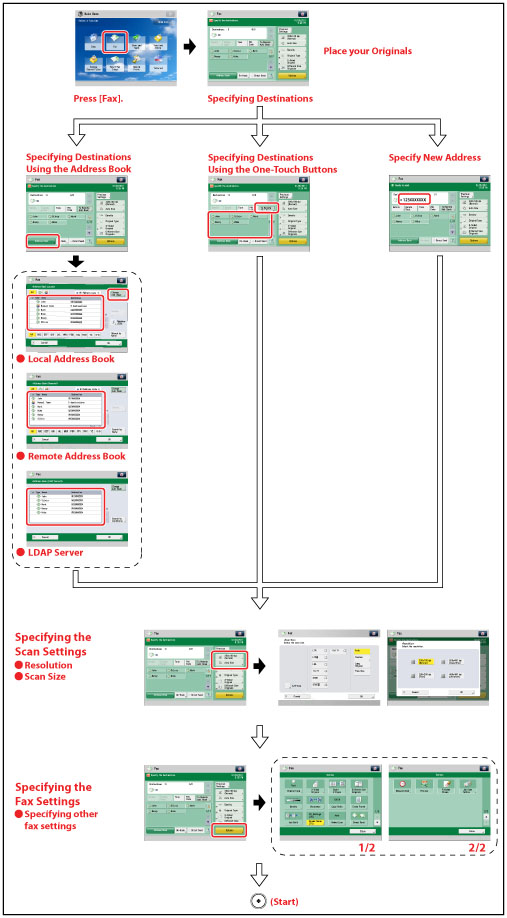
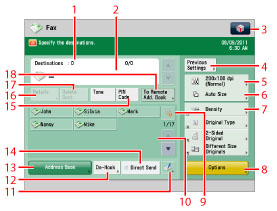
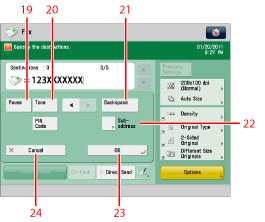
|
1
|
Destinations
Displays the number of specified destinations.
|
|
2
|
Destination
Displays the destination entered using the numeric keys.
|
|
3
|
 You can specify the following settings:
Register to Quick Menu
Change Default Settings
Register Options Shortcuts
Change Default LDAP Search Conditions
Register/Edit Information for Each User
[Register/Edit Information for Each User] appears only if you are managing users by login service such as SSO-H. For more information, see "Authentication Method Settings for Sending Operations."
|
|
4
|
[Previous Settings]
Press to recall the last three send jobs, including the destinations, scan settings, and send settings.
|
|
5
|
Resolution
Press to specify the resolution.
|
|
6
|
Scan Size
Press to specify the size for scanning.
|
|
7
|
Shortcuts to [Options]
Press to select an [Options] mode. [Density], [Original Type], [2-Sided Original], and [Different Size Originals] are set as default. (See "Assigning Shortcuts.")
|
|
8
|
[Options]
Press to set useful fax functions such as sending different sized originals together or 2-sided originals.
|
|
9
|
One-Touch Button Number Entry Button
Press to specify the destination by entering the number for a one-touch button.
|
|
10
|
One-Touch Buttons
Press to specify destinations stored in one-touch buttons.
|
|
11
|
Register One-Touch Button
Press to register destinations in one-touch buttons.
|
|
12
|
[On-Hook]
Press to use tone dialing or to send a fax document manually. (See "Fax Information Services.")
|
|
13
|
[Address Book]
Press to select a destination from the Address Book.
|
|
14
|
[Direct Send]
Press to send documents directly to the recipient. If you do not select Direct Sending, Memory Sending is used instead. (See "Switching to Direct Sending.")
|
|
15
|
[PIN Code]
Press to enter the PIN (Personal Identification Number) code. You can press this key only if [Option] is selected for PIN code position. If [Prefix], [Suffix], or [Off] is selected for PIN code position, this key is grayed out. (See "Using a PIN Code.")
|
|
16
|
[Details]
Press to check or change the selected destination.
|
|
17
|
[Delete Dest.]
Press to delete the selected destination.
|
|
18
|
[To Remote Add. Book]
Press to specify destinations registered in the one-touch buttons of a server machine by accessing from a client machine on the network.
|
|
19
|
[Pause]
Press to insert a pause of several seconds in the fax number that you are dialing. If you press [Pause] betwewn numbers, the letter <p> appears between the numbers. If you press [Pause] at the end of a number, the letter <P> appears at the end of the number. When dialing an overseas number, insert a pause after the country code, and at the end of the telephone number. (See "Pause Time.")
|
|
20
|
[Tone]
Press when you want to directly call an extension line that is connected to a PBX (Private Branch eXchange) which accepts only tone signals. If you press [Tone], the letter <T> appears.(See "Fax Information Services.")
|
|
21
|
[Backspace]
Press when you enter an incorrect number to delete the number before the cursor.
|
|
22
|
Subaddress
Press to set an optional subaddress and password. Specify the settings as necessary.
[Set Details]
Displayed when multiple lines are set to be used. Press to set the subaddress and password, or to select the telephone line to use for transmission.
|
|
23
|
[OK]
Press after specifying a destination using
 to to  (numeric keys). You can specify another destination. (numeric keys). You can specify another destination. |
|
24
|
[Cancel]
Press to return to the previous screen.
|
|
NOTE
|
|
If you set [Display Fax Function] to 'Off', [Fax] does not appear in the Main Menu. (See "Display Fax Function.")
You can use multiple lines in the following cases:
If the Super G3 2nd Line Fax Board is installed in addition to installing the Super G3 FAX Board, or the Super G3 3rd/4th Line Fax Board is installed in addition to installing the Super G3 2nd Line Fax Board and Super G3 FAX Board.
If [No. of TX Lines] is set to two lines when using the Fax function with the Remote Fax Kit. (See "Remote Fax TX Settings.")
|
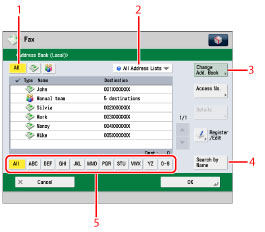
|
1
|
Specify Type of Destination drop-down list
If you press [All],
 (Fax) or (Fax) or  (Group), destinations for each type appear. (Group), destinations for each type appear. |
|
2
|
Address List drop-down list
Press the Address List drop-down list to display a list of Address Lists 1 to 10 or one-touch buttons. Address lists categorize the addresses stored in the Address Book.
|
|
3
|
Change Address Book
If you press [Change Add. Book], you can switch the display to the [Local], [Remote], or [LDAP Server] address book.
|
|
4
|
[Search by Name]
If you press [Search by Name], a pop-up screen for refining the address book appears.
|
|
5
|
Search Initial Letter button
Press the alphanumeric keys (e.g., [ABC]) to display the individual keys for each letter or number. You can select a letter or number to restrict the displayed range of entries. Press [All] to return to the full address list.
|
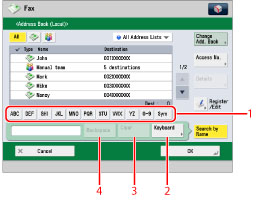
|
1
|
[ABC] - [Sym]
Displays the characters you can enter. The range of letters or the symbols you can enter are displayed.
|
|
2
|
[Keyboard]
Displays the keyboard on the touch panel display.
|
|
3
|
[Clear]
Press to delete all of the text entered.
|
|
4
|
[Backspace]
Press to delete the last letter entered.
|
|
NOTE
|
|
Press [Search by Name] to close the screen for refining the address book and return to the previous screen.
If you select [All], destinations registered in one-touch buttons also appear. However, you cannot delete destinations registered in one-touch buttons. For instructions on deleting one-touch buttons, see "Storing/Editing/Deleting One-Touch Buttons."
To cancel a selected destination, select the destination again.
[Access No.] appears only on the screen if [Manage Address Book Access Numbers] is set to 'On'. (See "Managing the Address Book with Access Numbers.")
|